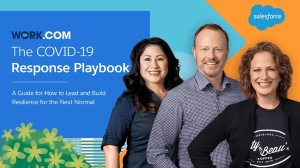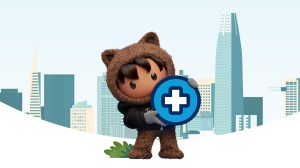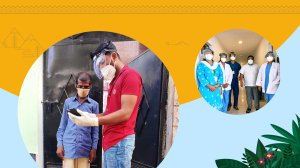The COVID-19 pandemic continues to grow and morph, with new layers and complexities revealing themselves on a daily basis. For business leaders, concerns are amplified. They have companies to run, employees to protect, and relationships to manage. This complicates every decision as we navigate our way through to the other side of this crisis and get the economy back on track. Not surprisingly, in a study surveying decision makers in the B2B space conducted by Salesforce Customer & Market Insights team, nearly a third of respondents said their top concern during the crisis was keeping the business running, followed by staying connected to customers.
“In a moment of crisis, it’s difficult to think beyond the next hour, the next day, or the next week. This is a very human crisis, and many important decisions have to be taken quickly. For most business leaders, this is therefore a pivotal time. There is enormous pressure on leaders to step up and provide the structure, guidance, and clear communication that people are looking for.”
Simon Mulcahy, Salesforce Chief Innovation Officer
An important new resource is Salesforce’s COVID-19 Response Playbook, a simple, organized way for businesses and communities to identify immediate and long-term decisions they can make now that will prepare them to move out of the crisis. Synthesizing a vast library of insights from customer transformation programs, a detailed COVID-19 scenario program, field research, engagements with governments, the World Economic Forum, and regular customer roundtables, Salesforce pulled together its customers and partners to help put structure around what decisions should be made, and when.
There may be more uncertainty ahead when it comes to the coronavirus – how it will continue to affect daily life and the ripple effects it will have on the economy, to name two huge concerns. But one thing that is certain is the old ways of doing business are becoming obsolete even quicker.
“The reality is that we were already living in a world where change was accelerating,” says Mulcahy. “The new normal we find ourselves in is further accelerating many of the pre-crisis trends around how we live and work, especially around digital. Additionally, most businesses operate based on models designed around assumptions. Many of these assumptions are decades old, products of an analogue world. Leaders really need to reassess their customers’ needs with a beginner’s mind to maximize relevance for both today and tomorrow. Getting that right will set you up for the ‘Next Normal.’”
But first, business leaders will need to ask themselves two core questions:
- What decisions can I make now to ensure my business is resilient in the next normal?
- How can I make sure that I see the signs for change early enough, so I can act quickly when the time is right?
Times are too chaotic for business leaders to take on everything at once – they have to consider the immediacy of the present, response tactics, and then longer-term strategies for recovery and success in the next normal. And not all companies operate on the same playing field. The crisis is hitting us all differently depending on our industries, geographies, and customer bases. Some are far along on their digital journeys, which makes adjusting slightly less daunting and may actually be well positioned to succeed in this market. Others may be struggling to stabilize due to a lack of infrastructure to make quick decisions and will need to focus on stability before navigating the future.
Whatever the case, the COVID-19 Response playbook advises leaders in every organization to assess how customer-centric they really are to define what comes next. And wherever a business is in its particular lifecycle, the playbook maps out three distinct but often concurrent tracks that can help navigate big decisions.
The playbook also identifies four considerations to help businesses take action in each of these three phases:
- How to make decisions: Leveraging customer and employee data to enable team collaboration.
- How to work: Communicating open and transparently with employees, while empowering productivity and skills-development.
- How to engage customers: Enhancing the way businesses sell, market, and service customers from anywhere.
- How to serve society: Mobilizing employees to be platforms for change, well beyond the crisis.
Track 1: Stabilize
For any effective leader, the early days of the crisis drove them to immediately think about acting fast to protect the health and safety of their employees, and to provide immediate and continuing support for their customers. In other words, quick decisions to stabilize their businesses.
But a plan for stability is about more than just a crisis response team. For one, leaders need to consider how they focus their decision-making to redirect resources to the most critical areas of their companies’ response to the pandemic.
The next step is formulating a plan to prioritize employees – specifically their well-being and safety, while inspiring them to keep performing at a high level, especially if the majority of them are currently working from home. Then it’s about connecting with customers, partners, and suppliers and keeping an open line of communication with them. Leaders should also think about how to give back to their communities, either in tangible resources like products or donations, or empowering employees to volunteer on company time.
Track 2: Reopen
After stability comes a plan for a safe reopening of the workplace. To do that, companies must listen to and collect insights from customers to inform smart decision-making, and an action plan that will extend through their entire ecosystem.
Employees are next. The playbook prioritizes a back-to-work plan with tools and processes that will ensure workers stay safe and can maintain work-life balance. Parents in particular are stretched to their limits right now, so as with all employees, communication and empathy is key to ensure they feel valued and supported. Offering up opportunities to be involved in their communities is also an important factor.
Maintaining good communication with customers, partners, and suppliers is another key to reopening safely. Partnering with all of them will ensure their specific needs are being met as business priorities shift during this crisis.
Track 3: Grow
Once operations are stabilized and offices have reopened, leaders can once again focus on the growth of their businesses. This is an opportunity to come out of this crisis even stronger. That requires a refresh and, in many cases, a full reinvention. For instance, businesses should consider a dedicated transformation office that will help bring vision and strategy to life. This could take the form of a V2MOM, (vision, values, methods, obstacles, and measures), the framework Salesforce uses and recommends to map transformative goals to action and milestones to drive alignment around that strategy.
Company culture may also have to change. Leaders must put consideration into how to best empower their workforce in the next normal, which can include anything from remote and flexible work options to upskilling opportunities and wellness programs. Customer-centricity needs to go into hyperdrive, and processes need to be reimagined with how to best deliver to and support customers instead of org charts and departments.
And finally, leaders must realize business is the greatest platform for change. In the next normal, organizations must focus on how they’re improving society – for instance, setting up employee giveback programs, establishing sustainability initiatives as core parts of a company’s DNA, even appointing a chief impact officer to drive all of the above.
At the end of the day, companies that rise to the occasion during these challenging times aren’t just the ones who will survive and thrive. They’ll be the ones who are shaping this next normal and influencing how we continue to serve customers in the most effective and life-changing ways.
For more on how Salesforce is supporting businesses through COVID-19, visit Work.com, our Leading Through Change resources, and this press release.
















